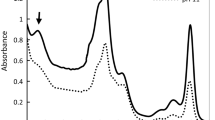Abstract
Sodium fluoride showed pH-dependent physiological responses in the two test microalgaeAnabaena khannae andChlorococcum humicola. A. khannae showed severe membrane damage with fluoride at low pH with leakage of pigments and electrolytes. Annihilation of photosynthesis along with inhibition in14C uptake was observed at pH 6 with 50 mg/L fluoride. While respiration was less affected in the cyanobacterium,C. humicola showed 30 % inhibition in respiratory activity. Resistance ofC. humicola to fluoride toxicity has been attributed to the hindrance provided by the thick cell envelope, intracellular compartmentation and increase in extracellular pH as a consequence of its metabolism.
Similar content being viewed by others
References
Badger M.R., Andrews T.J.: Photosynthesis and inorganic carbon usage by the marine cyanobacteriumSynechococcus sp.Plant Physiol. 70, 517–523 (1982).
Bennett A., Bogorad L.: Properties of subunits and aggregates of blue green algal biliproteins.Health Lab.Sci. 3, 90–100 (1971).
Bhatnagar M.: Fluoride tolerance in microalgae and its ecological implications.PhD Thesis. Indian Agricultural Research Institute, New Delhi 1997.
Deane-Drummond C.E.: Biochemical and biophysical aspects of nitrate uptake and its regulation, pp. 1–37 in Y.P. Abrol (Ed.):Nitrogen in Higher Plants. John Wiley and Sons, New York 1990.
Giannini J.L., Briskin O.P., Miller G.W.: Effect of fluoride on the ATPase activity and membrane transport in isolated tonoplast vesicles from sugar beet.Plant Physiol. 83, 709–712 (1987a).
Giannini J.L., Briskin D.P., Miller G.W.: Effect of fluoride on the plasmalemmal ATPase activity of sugar beet protoplasts.Plant Sci. 53, 39–44 (1987b).
Gutnekcht J., Walter A.: Hydrofluoric and nitric acid transport through lipid bilayer membranes.Biochem.Biophys.Acta 644, 153–156 (1980).
Hekman W.E., Budd K., Palmer G.R., Mac Arthur J.D.: Response of certain fresh water planktonic algae to fluoride.J.Phycol. 20, 243–249 (1984).
Hochachka P.W., Teal J.M.: Respiratory metabolism in a marine dinoflagellate.Biol.Bull. 126, 274–281 (1964).
Klut M.E., Bisalputra T., Antia N.J.: Abnormal ultrastructural features of a marine dinoflagellate adapted to grow successfully in the presence of inhibitory fluoride concentration.J.Protozool. 28, 406–414 (1981).
Kumar A., Tabita S.R., van Ballen C.: Isolation and characterization of heterocysts fromAnabena sp. strain CA.Arch.Microbiol. 133, 103–109 (1982).
Larslander L.: Chemicals in the aquatic environment, pp. 223–225 in R.S. DeSanto (Ed.):Advanced Hazard Assessment. Springer Ser. Environmental Management, Springer-Verlag, Berlin 1989.
Mac Kinney G.: Absorption of light by chlorophyll solutions.J.Biol.Chem. 140, 315–322 (1941).
McKee J.E., Wolf H.W.:Water Quality Criteria, Vol. 3A, 2nd ed., pp. 140–141 (Resources Agency of California, no. 3A), State Water Resources Control Board, Sacramento (USA) 1963.
Miller G.W.: The effect of fluoride on higher plants — with special emphasis on early physiological and biochemical disorders.Fluoride 26, 3–22 (1993).
Nichol B.E., Budd K., Palmer G.R., Mac Arthur J.D.: The mechanism of fluoride toxicity and fluoride resistance inSynechococcus leopoliensis (Cyanophyceae).J.Phycol. 23, 535–541 (1987).
Smith A.O., Woodson B.R.: The effects of fluoride on growth ofChlorella pyrenoidosa.Vir.J.Sci. 16, 1–8 (1965).
Stanier R.Y., Kunisawa R., Mandel M., Cohen Bazire G.: Purification and properties of unicellular blue green algae (order:Chroococcales).Bacteriol.Rev. 35, 171–205 (1971).
Thomas M.L.H.: Photosynthesis and respiration of aquatic microflora using the light and dark bottle oxygen method and dissolved oxygen analyser, p. 64 in C.S. Lobban, D.J. Chapman, B.P. Kremer (Eds):Experimental Phycology. A Laboratory Manual. Cambridge University Press, Cambridge 1988.
Vogel G.L., Mao Y., Chow L.C., Proskin H.M.: Fluoride in plaque fluid, plaque, and saliva measured for 2 h after a sodium fluoride monofluorophosphate rinse.Caries Res. 34, 404–411 (2000).
Author information
Authors and Affiliations
Rights and permissions
About this article
Cite this article
Bhatnagar, M., Bhatnagar, A. Physiology ofAnabaena khannae andChlorococcum humicola under fluoride stress. Folia Microbiol 49, 291–296 (2004). https://doi.org/10.1007/BF02931045
Received:
Revised:
Issue Date:
DOI: https://doi.org/10.1007/BF02931045




